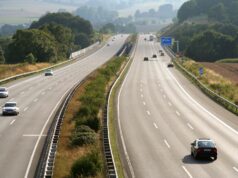
The Essentials
No, if you have a valid driver’s license from your home country, you can use it for up to six months in Germany. How to get a car in Germany…
Yes and no. Some sections of the Autobahn have no speed limit, but others do. The general recommended speed is 130 km/h (80 mph), but you should always follow the signs and adjust to the traffic conditions.
There are many road signs in Germany, but some of the most important ones are: Vorfahrt (priority), Stop (stop), Einbahnstraße (one-way street), Umleitung (detour), and Ausfahrt (exit). More rules…
Driving rules in Germany are necessary to have a fun and exciting driving experience, but it does require some preparation and knowledge. In this article we will give you some tips and advice on how to drive safely and legally in Germany, as well as some information on how to get a car, register it and maintain it.
Getting a car in Germany

There are several ways to get a car in Germany, depending on your needs and budget. Here are some of the more common options:
1. Buy a car
If you want to own a car in Germany, you can buy one from a dealer or private seller. You will have to pass a technical inspection every two years and pay taxes, insurance and registration fees. Buying a car can be expensive, but it gives you more freedom and flexibility.
2. Rent a car
If you only need a car for a short period of time, you can rent one from various companies. You will need a valid driver’s license, a credit card, and sometimes an international driver’s license. You will also need to pay for gas, tolls, and parking. Renting a car can be convenient, but it can also be expensive and restrictive.
3. Carpool/Car share
If you want to save money and reduce your environmental impact, you can use carpooling or car sharing services. Carpooling is when you share a ride with someone who is traveling in the same direction as you.
Car sharing is when you use a car that belongs to a company or community for a short period of time. You must sign up online, pay a fee, and follow the rules of the service. Carpooling and car sharing can be cheap and environmentally friendly, but they can also be unreliable and limited.
Tip: Before you get a car in Germany, compare the prices and conditions of different options. You can use online tools to find the best deals.
Rules and Regulations for Driving in Germany

Driving in Germany is not very different from driving in other countries, but there are some specific rules and regulations that you should know and follow.
- Drive on the right side of the road and pass on the left.
- Always wear your seatbelt when driving. Your passengers should do the same.
- Do not use your phone or any other device while driving. You can use hands-free kits or voice commands.
- Do not drink and drive. The legal blood alcohol limit is 0.5 permille, but it is lower or zero for novice and professional drivers.
- Obey speed limits. They are different depending on the type of road and also of the weather conditions. The general limits are 50 km/h (31 mph) in urban areas, 100 km/h (62 mph) on country roads and 130 km/h (80 mph) on motorways. However, some sections of motorway have no speed limit, so you should drive according to your ability and the traffic situation.
- Follow the road signs. They are color-coded and have different shapes and symbols. Some of the most common ones are: red circles (prohibitions), blue circles (obligations), yellow diamonds (priority roads), white rectangles (information), yellow triangles (warnings), and blue squares (directions).
- Respect the right of way. In general, drivers coming from the right have the right of way unless a sign or traffic light indicates otherwise. At roundabouts, drivers who are already inside the roundabout have the right of way over those entering the roundabout.
- Use your lights properly. You should always use your low beam when driving at night or in poor visibility conditions. You should also use your high beams when there is no oncoming traffic or when passing another vehicle. It’s important to use your turn signals when changing lanes or directions and your hazard lights to warn other drivers of a hazard or emergency.
Parking in Germany
Parking in Germany can be a challenge, especially in large cities and tourist areas. You should always look for a designated parking space and pay attention to signs and markings. Here are some of the most common parking rules and regulations in Germany:
- Do not park on sidewalks, bike lanes, crosswalks, bus stops, in front of driveways or fire hydrants.
- Do not park on the left side of the street unless it is a one-way street or there is a sign that says so.
- Do not park within 5 meters (16 feet) of an intersection or crosswalk, or within 15 meters (49 feet) of a bus stop or railroad crossing.
- Do not park in spaces reserved for the disabled, electric vehicles, car sharing or residents unless you have a valid permit or authorization.
- Do not park in zones marked with blue lines unless you have a parking disc indicating your arrival time. You can get a parking disc at gas stations, car rental agencies or tourist offices. The maximum parking time is usually one or two hours.
- Pay for your parking. You can use parking meters, ticket machines, mobile apps or online platforms to pay for your parking. Rates vary by location and duration. You should display your ticket or receipt on your dashboard.
Advice: If you are unsure about where to park or how to pay, you can ask a local or a police officer for help.
Traffic accidents and breakdowns in Germany

Even if you drive carefully and follow the rules, you may encounter problems on the road, such as accidents or breakdowns. If this happens, you should know what to do and who to contact.
First of all, stop your vehicle and turn on your hazard lights. If possible, move your vehicle to a safe place, such as the shoulder or emergency lane. Put on your reflective vest and place your warning triangle at least 100 meters (328 feet) behind your vehicle, or more if you are on a highway or around a curve.
Then, check for injuries and call emergency services if necessary. The number for police, fire and ambulance is 112. Exchange information with the other parties involved, such as name, address, phone number, license plate number, insurance company and policy number. Also, photograph the scene and the damage.
Please make sure to report the accident to your insurance company as soon as possible. You may need to fill out an accident report form describing what happened and who is responsible.
Advice: If your vehicle is damaged or malfunctioning, call a roadside assistance service for help. The number for the ADAC is 22 22 22 from any cell phone. They can tow your vehicle to a nearby garage or make minor repairs on the spot.
Lots of fun with the right knowledge
Now, you know how to start driving in Germany. First, you need a car, then you have to follow the rules that apply to Germany. For example, you should drive on the right side and follow the signs on the road.
If you happen to rush into an accident, you can call 112 and exchange informations with the other person that is involved. Now, start enjoying Germany’s landscape and cities!
















